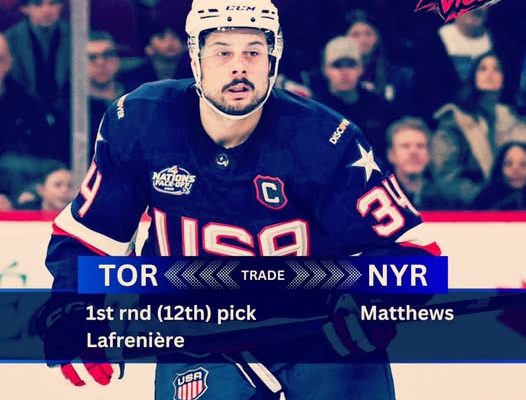**The New York Rangers Finally Complete the Rebuild, Sending the Leafs into Their Own**
The New York Rangers have officially turned the page on their rebuild, marking the end of an era defined by patience, strategic drafting, and calculated trades. In a move that solidifies their transition from rebuilding to contending, the Rangers have traded a package including the 12th overall pick and a young, high-potential forward to the Toronto Maple Leafs—a deal that not only strengthens New York’s immediate roster but also signals a shift in direction for both franchises.
For years, the Rangers embraced a patient approach, accumulating draft capital and developing young talent. The fruits of that labor are now evident, with cornerstone players like Alexis Lafrenière, Kaapo Kakko, and Adam Fox leading the charge. Meanwhile, Igor Shesterkin has established himself as one of the NHL’s elite goaltenders, providing the stability needed for a deep playoff run. With a core now in its prime, the Rangers have pivoted from asset collection to win-now mode, sacrificing future potential for immediate impact.
The trade with Toronto underscores this philosophy. By moving the 12th overall pick—a valuable asset in a deep draft—along with a promising young forward, the Rangers are clearly targeting established talent to bolster their lineup. Speculation suggests this could be part of a larger deal to acquire a top-six forward or a reliable defenseman, addressing needs that could push them over the top in a competitive Eastern Conference.
On the other side, the Maple Leafs find themselves at a crossroads. After years of playoff disappointments despite boasting one of the most talented cores in the league—Auston Matthews, Mitch Marner, William Nylander, and John Tavares—the organization appears to be acknowledging the need for a retool, if not a full rebuild. Acquiring the 12th overall pick and a high-upside prospect suggests a willingness to inject youth into a roster that has struggled to translate regular-season success into postseason glory.
For Toronto, this trade could be the first domino to fall in a larger reshuffling of the roster. With salary cap constraints and persistent questions about their defensive structure and playoff toughness, the Leafs may be preparing for life beyond some of their current stars. The addition of a mid-first-round pick allows them to draft a cost-controlled player who can contribute in the coming years, while the young forward acquired in the deal offers potential upside.
### **Why This Trade Makes Sense for the Rangers**
The Rangers are in a unique position where their window to compete is wide open. With a strong defensive corps led by Fox and K’Andre Miller, elite goaltending, and a forward group that blends skill and physicality, they are built for playoff hockey. However, depth scoring and defensive consistency have been lingering concerns. By trading futures for proven talent, general manager Chris Drury is making a clear statement: the time to win is now.
The 12th overall pick, while valuable, is unlikely to contribute immediately. The Rangers already have a pipeline stocked with prospects, meaning they can afford to part with a draft selection to address immediate needs. The young forward included in the deal, while promising, may have been expendable given New York’s depth at wing.
If this trade precedes another move—such as acquiring a player like a top-four defenseman or a gritty two-way forward—it could be the final piece that solidifies the Rangers as true Stanley Cup contenders.
### **What This Means for the Maple Leafs**
For Toronto, this trade represents a potential shift in philosophy. Despite regular-season dominance, the Leafs have repeatedly fallen short in the playoffs, leading to growing frustration among fans and management. While the core remains intact for now, adding draft capital suggests that new GM Brad Treliving is considering a more sustainable approach.
The 12th overall pick gives Toronto an opportunity to draft a high-ceiling player who can develop alongside—or eventually replace—current stars. Meanwhile, the young forward acquired from New York could blossom into a key contributor, providing much-needed secondary scoring or defensive responsibility.
However, the bigger question is whether this signals the start of a larger tear-down. If the Leafs struggle early next season, could Matthews, Marner, or Nylander become trade candidates? While that remains speculative, this deal at least indicates that Toronto is open to reshaping its roster rather than running it back with the same group.
### **The Bigger Picture: Two Franchises Heading in Opposite Directions**
This trade is a microcosm of where these two franchises stand. The Rangers, after years of rebuilding, are now in “go for it” mode, leveraging future assets to maximize their current roster. The Leafs, after years of trying (and failing) to break through, may finally be acknowledging that change is necessary.
For New York, the pressure is now on to deliver. With a reinforced lineup, expectations will be sky-high, and anything short of a deep playoff run will be seen as a disappointment. For Toronto, the focus shifts to the future—whether that means a soft reset around their stars or a more dramatic overhaul remains to be seen.
One thing is certain: the NHL landscape is always evolving, and this trade could be remembered as the moment the Rangers officially arrived as contenders—while the Leafs began their own journey back to the drawing board.



